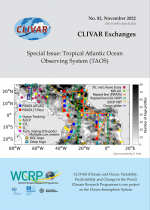Ocean Carbon Hot Spots Workshop
Biophysical drivers of carbon uptake in western boundary current regions
Objectives
Western boundary current (WBC) regions display the largest magnitude air-to-sea carbon dioxide (CO2) fluxes of anywhere in the global ocean, exhibit large spring blooms and high eddy activity, and are hubs for the subduction of anthropogenic carbon-laden waters into the ocean interior during mode water formation. Yet the influence of biophysical interactions on air-sea CO2 exchange and carbon export has not been rigorously evaluated in most WBC regions.
The term Ocean Carbon Hot Spots refers to the WBC regions of the ocean, which exhibit large mean annual air-to-sea CO2 fluxes (blue regions in Figure 1a) and elevated surface eddy kinetic energy (blue regions in Figure 1b) – characteristics ideal for the study of biophysical interactions and carbon cycle processes.














